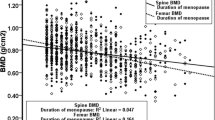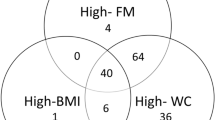Abstract
This cross-sectional study covered 301 individuals over 70 years of age—207 women (W) and 94 men (M)—living in the city of São Paulo, Brazil. Our aims were to evaluate the prevalence of low bone mineral density (BMD) in this population and the possible factors that influence BMD. The subjects were submitted to a bone densitometry scan (DXA) to evaluate the BMD at lumbar spine (LS), femoral neck (FN), trochanter (T), total femur (TF) and total body composition. At the time, the participants filled in a questionnaire about lifestyle habits, diet and medical history, as well as having blood samples taken to check hormone and biochemical levels. Anthropometric parameters were measured. Osteopenia and osteoporosis were defined in accordance with the criteria suggested by the World Health Organization. In the different sites studied, the prevalence of osteopenia and osteoporosis varied, in men ranging 33.3–57.4% and 6.4–16.1%, respectively, and in women ranging 36.6–56.5% and 22.2–33.2%, respectively. Weight was the variable that most strongly correlated with BMD at the proximal femur in both sexes (men, r =0.44–0.52; women, r =0.48–0.52) and with BMD at LS in women ( r =0.44). Height was the parameter that best correlated with BMD at LS in men ( r =0.34). In men follicle-stimulating hormone, growth hormone and glycemia correlated with BMD at T and TF, while plasma albumin only correlated with BMD at T. In women glycemia correlated with BMD at LS, and follicle-stimulating hormone correlated with BMD at FN, T and TF. In conclusion, we found a high prevalence of osteopenia and osteoporosis in this population, with weight being the best predictor of BMD. The prevalence of osteoporosis and osteopenia at FN was as high in men as that observed in women.



Similar content being viewed by others
References
Kanis JA, Glüer CC (2000) An update on the diagnosis and assessment of osteoporosis with densitometry. Osteoporos Int 11:192–202
Ross PD (1996) Osteoporosis: frequency, consequences, and risk factors. Arch Intern Med 156:1399–1411
Eastell R (1999) Bone density can be used to assess fracture risk [comment]. BMJ 318:864–865
Hawker GA (1996) The epidemiology of osteoporosis. J Rheumatol 23 [Suppl 45]: 2–5
Ramos LR, Toniolo J, Cendoroglo MS et al (1998) Two-year follow-up study of elderly residents in S. Paulo, Brazil: methodology and preliminary results. Rev Saude Publica 32 (5): 397–407
Wark JD (1999) Osteoporosis: a global perspective. Bull World Health Organ 77(5): 424–426
Viana PRS (1999) Avaliação da densidade mineral óssea e da ocorrência de fratura vertebral em pacientes com lupus eritematoso sistêmico [master thesis]. Federal University of São Paulo, São Paulo, Brazil, p 18
Kelly TL (1990) Bone mineral density reference databases for American men and women. J Bone Miner Res 5 [Suppl 2]:S249
Looker AC, Wahner HW, Dunn WL et al (1998) Updated data on proximal femur bone mineral levels of US adults. Osteoporos Int 8:468–489
Tenenhouse A, Joseph L, Kreiger N et al (2000) Estimation of the prevalence of low bone density in Canadian women and men using a population-specific DXA reference standard: the Canadian Multicentre Osteoporosis Study (CaMos). Osteoporos Int 11:897–904
VanItallie TB, Mei-Uih Y, Heymsfield SB et al (1990) Height-normalized indices of body’s fat-free mass and fat mass: potentially useful indicators of nutritional status. Am J Clin Nutr 52:953–959
Vieira JGH, Lombardi MT, Nishida SK (1990) Monoclonal antibody-based immunoenzymometric assay for serum human growth hormone. Braz J Med Biol Res 23:293–296
Vieira JGH, Nishida SK, Lombardi MT et al (1990) Desenvolvimento de ensaio imunoenzimométrico em anticorpos monoclonais para a dosagem de hormônio luteotrófico (LH) no soro. Rev Bras Pat Clin 26(3):84–87
Vieira JGH, Furlanetto RP, Russo EMK et al (1980) Radioimunoensaio do sulfato de deidroepiandrosterona: metodologia e padronização de valores normais. Arq Bras Endocrinol Metabol 24(2):79–83
Vieira JGH, Kunii IS, Nishida SK et al (1992) Desenvolvimento e aplicação de um método imunofluorométrico para a dosagem de tirotrofina humana (TSH) no soro e em sangue total colhido em papel de filtro. Arq Bras Endocrinol Metabol 36(1):7–12
Vieira JGH, Nishida SK, Lombardi MT et al (1994) Emprego de anticorpos monoclonais no desenvolvimento de um ensaio imunofluorométrico de alta sensibilidade para a dosagem de FSH. Estudo dos níveis séricos em meninos normais nos diferentes estádios puberais. Arq Bras Endocrinol Metabol 38(2):76–81
Wheeler MJ, D’Souza A, Matadeen J et al (1996) Ciba Corning ACS: 189 testosterone assay evaluated. Clin Chem 42:1445–1449
Looker AC, Orwoll ES, Johnston CC et al (1997) Prevalence of low femoral bone density in older U.S. adults from NHANES III. J Bone Miner Res 12(11):1761–1768
IBGE: Instituto Brasileiro de Geografia e Estatística (2000) Censo demográfico 2000. Available from: http://www.ibge.gov.br/ibgeteen/noticias/brasileirosvivemmais.html
Ramos LR, Rosa TEC, Oliveira ZM, Medina MCG (1993) Perfil do idoso em área metropolitana na região sudeste do Brasil: resultados de inquérito domiciliar. Rev Saude Publica 27(2):87–94
Szejnfeld VL, Atra E, Baracat EC et al (1995) Bone density in white Brazilian women: rapid loss at the time around the menopause. Calcif Tissue Int 56(3):186–191
Castro da Rocha FA, Ribeiro AR (2003) Low incidence of hip fractures in an equatorial area. Osteoporos Int 14(6):496–499
Orwoll ES, Klein R (1995) Osteoporosis in men. Endocr Rev 16(1):87–116
Yang S, Taxel P (2002) Osteoporosis in older men: an emerging clinical problem. Clin Geriatrics 10(8):28–37
Zerbini CAF, Latorre MRO, Jaime PC et al (2000) Bone mineral density in Brazilian men 50 years and older. Braz J Med Biol Res 33(12):1429–1435
Blunt BA, Klauber MR, Barret-Connor EL et al (1994) Sex differences in bone mineral density in 1,653 men and women in the sixth through tenth decades of life: the Rancho Bernardo study. J Bone Miner Res 9(9):1333–1338
Orwoll ES, Oviatt SK, Mann T (1990) The impact of osteophytic and vascular calcifications on vertebral mineral density measurements in men. J Clin Endocrinol Metab 70(4):1202–1207
Jones G, White C, Nguyen T, Sambrook PN, Kelly PJ, Eisman JA (1996) Prevalent vertebral deformities: relationship to bone mineral density and spinal osteophytosis in elderly men and women. Osteoporos Int 6(3):233–239
Hannan MT, Felson DT, Dawson-Hughes B et al (2000) Risk factors for longitudinal bone loss in elderly men and women: the Framingham Osteoporosis Study. J Bone Miner Res 15(4):710–720
Khosla S, Melton LJ III, Riggs BL (2002) Estrogen and the male skeleton. J Clin Endocrinol Metab 87(4):1443–1450
Hui SL, Perkins AJ, Zhou L et al (2002) Bone loss at the femoral neck in premenopausal white women: effects of weight change and sex-hormone levels. J Clin Endocrinol Metab 87(4):1539–1543
Riggs BL, Khosla S, Melton LJ III (2002) Sex steroids and the construction and conservation of the adult skeleton. Endocr Rev 23(3):279–302
Harman SM, Metter EJ, Tobin JD et al (2001) Longitudinal effects of aging on serum total and free testosterone levels in healthy men. J Clin Encocrinol Metab 86(2):724–731
Seeman E (1999) Osteoporosis in men. Osteoporos Int [Suppl 2]:S97–S110
Greendale GA, Edelstein S, Barrett-Connor E (1997) Endogenous sex steroids and bone mineral density in older women and men: the Rancho Bernardo Study. J Bone Miner Res 12(11):1833–1843
Rudman D, Drinka PJ, Wilson CR et al (1994) Relations of endogenous anabolic hormones and physical activity to bone mineral density and lean body mass in elderly men. Clin Endocrinol (Oxf) 40(5):653–661
Center JR, Nguyen TV, Sambrook PN, Eisman JA (1999) Hormonal and biochemical parameters in the determination of osteoporosis in elderly men. J Clin Endocrinol Metab 84(10):3626–3635
Martínez Díaz-Guerra G, Hawkins F, Rapado A, Ruiz Díaz MA, Díaz-Curiel M (2001) Hormonal and anthropometric predictors of bone mass in healthy elderly men: major effect of sex hormone binding globulin, parathyroid hormone and body weight. Osteoporos Int 12:178–184
Smerdely P, Seller M, Smith A et al (2000) Predictors of bone mass in healthy older men in the community. Med J Aust 173:183–186
Khosla S, Melton LJ III, Atkinson EJ et al (1998) Relationship of serum sex steroid levels and bone turnover markers with bone mineral density in men and women: a key role for bioavailable estrogen. J Clin Endocrinol Metab 83(7):2266–2274
Edelstein SL, Barrett-Connor E (1993) Relation between body size and bone mineral density in elderly men and women. Am J Epidemiol 138(3):160–169
Reid IR (2002) Relationships among body mass, its components, and bone. Bone 31 (5): 547–555
Author information
Authors and Affiliations
Corresponding author
Rights and permissions
About this article
Cite this article
Rodrigues Camargo, M.B., Cendoroglo, M.S., Ramos, L.R. et al. Bone mineral density and osteoporosis among a predominantly Caucasian elderly population in the city of São Paulo, Brazil. Osteoporos Int 16, 1451–1460 (2005). https://doi.org/10.1007/s00198-004-1831-y
Received:
Accepted:
Published:
Issue Date:
DOI: https://doi.org/10.1007/s00198-004-1831-y




